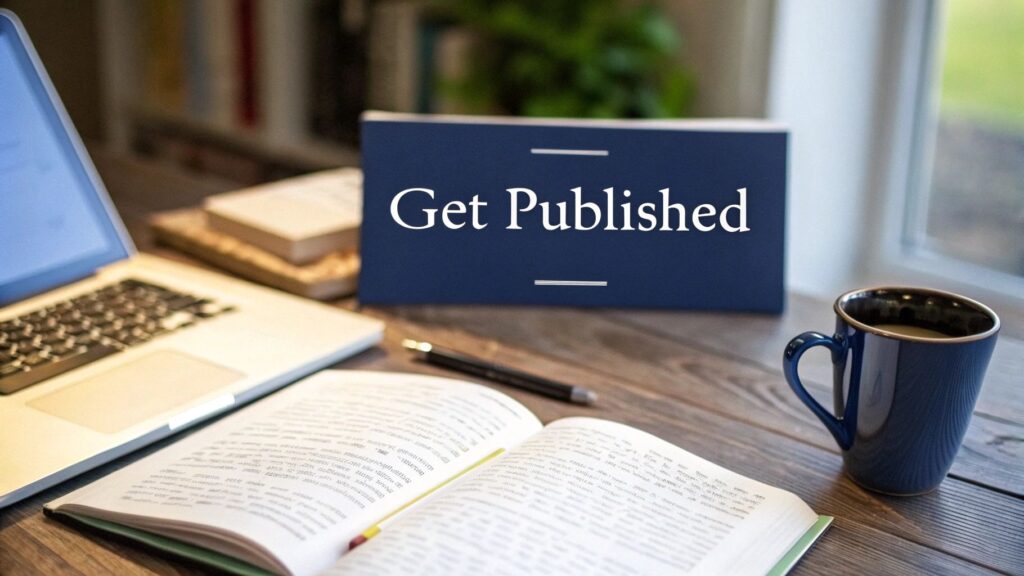So, you've written a book. Congratulations! That's a huge accomplishment, but as you're probably realizing, finishing the manuscript is just the beginning. Now comes the big question: how do you get it into the hands of readers?
You're essentially standing at a crossroads with two distinct paths in front of you. The first is traditional publishing, the classic route of agents, publishing houses, and bookstore placements. The second is self-publishing, a more independent, entrepreneurial journey where you are in the driver's seat.
Neither path is inherently better than the other. The "right" choice really comes down to your personal goals, your budget, your timeline, and how much control you want to keep over your creative work.
Your Publishing Roadmap From Manuscript to Market
The journey from a Word document to a finished book can seem daunting. It’s a process filled with a lot of moving parts, from editing and design to distribution and marketing. Think of it less like a straight line and more like a series of crucial project phases.
Whether you're hoping to land a deal with one of the "Big 5" publishers or planning to upload your masterpiece directly to Amazon, understanding the entire landscape is your first, most important step.
Mapping Your Journey
Going the traditional route is often a test of patience and thick skin. It starts with a long, and sometimes grueling, search for a literary agent who believes in your book enough to represent it. If you land one, they'll then shop your manuscript to editors at publishing houses. It's a path that can lend a certain prestige and comes with the backing of an expert team, but be prepared for long waits—sometimes years—and to give up final say on things like your cover, title, and even some content.
Self-publishing, on the other hand, puts you in complete control. You're the publisher. You call all the shots, from hiring your own editor and cover designer to setting the price and publication date. This gives you incredible creative freedom and a much faster path to market. The trade-off? You're also responsible for funding the entire project and handling all the marketing yourself.
This infographic breaks down the major stages and highlights that fork in the road every author faces.
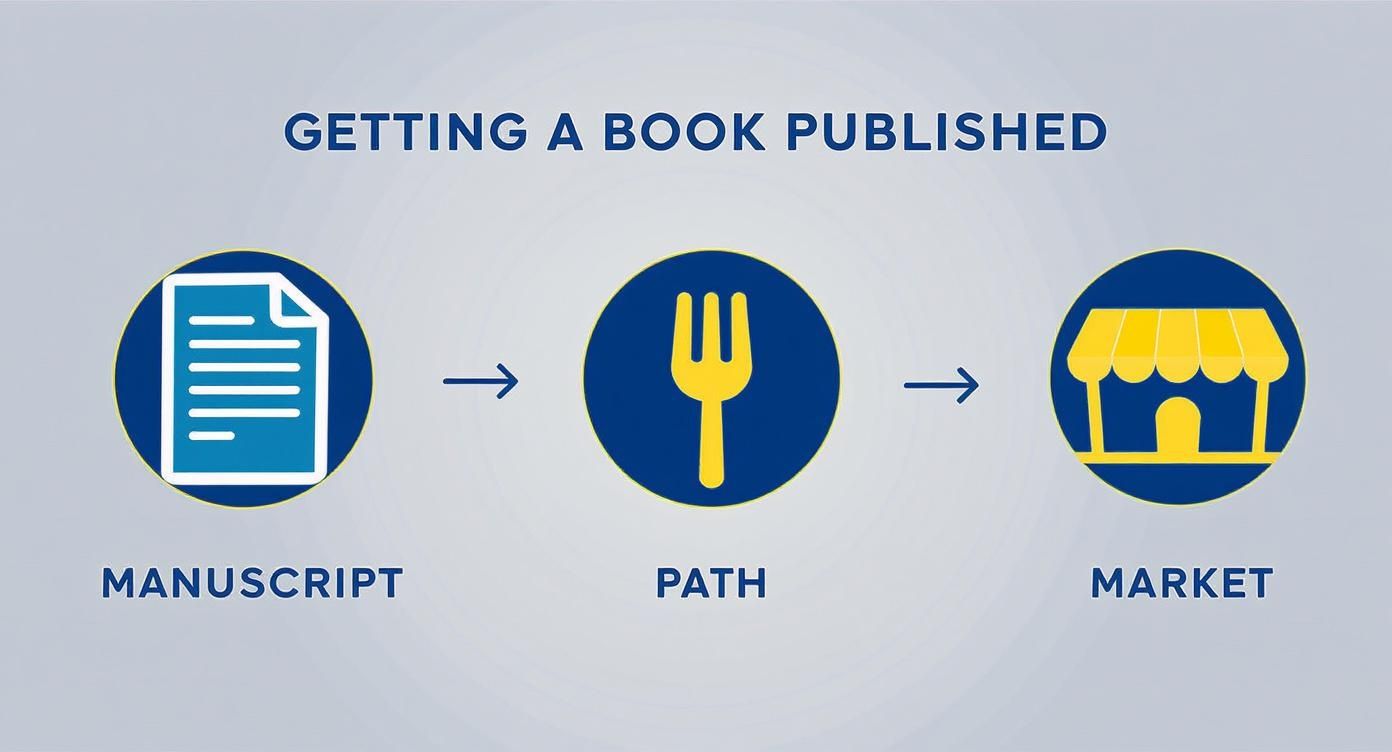
As you can see, while the journey differs, the destination is the same: connecting your story with an audience.
To help you weigh the pros and cons, here’s a quick breakdown of how the two paths stack up.
Traditional Publishing vs. Self-Publishing at a Glance
| Factor | Traditional Publishing | Self-Publishing |
|---|---|---|
| Upfront Cost | None for the author. The publisher invests in the book. | Author pays for everything: editing, design, marketing, etc. |
| Creative Control | Limited. The publisher has the final say on most creative decisions. | 100%. The author makes all final decisions. |
| Timeline | Slow. Often 18-24 months or more from signing a contract to launch. | Fast. Can be published in a matter of weeks or months. |
| Royalties | Lower. Typically 5-15% of net receipts. | Higher. Typically 40-70% of the list price. |
| Distribution | Broad. Strong access to physical bookstores and libraries. | Primarily online, with print-on-demand for physical copies. |
| Validation | Built-in "gatekeeper" validation from agents and editors. | Success is determined solely by the market and reader reviews. |
Ultimately, this table shows there's a clear trade-off between control and support. Your job is to decide which model aligns best with your vision for your book and your career.
Key Milestones to Expect
No matter which route you take, some steps are non-negotiable if you want to produce a professional-quality book that stands a chance in a crowded market. For a much more detailed breakdown, you can explore the complete stages of publishing a book and see what each phase truly entails.
Here are the universal milestones you’ll encounter:
- Getting the Manuscript Right: This isn't just about spell-checking. It means a deep developmental edit to fix plot holes, followed by a meticulous line edit to make your prose sing, and finally, a thorough proofread to catch any lingering typos.
- Professional Production: You can spot a self-published book from a mile away if the cover and interior formatting look amateurish. Investing in professional design is essential to compete.
- A Solid Distribution Plan: How will readers buy your book? For traditional authors, the publisher handles this. For indie authors, it means setting up your book on platforms like Amazon KDP, IngramSpark, and others.
- Relentless Marketing: Books don't sell themselves. Success requires building an author platform, engaging with potential readers online, and actively promoting your work long before and after it launches.
The single most important shift in mindset is to start treating your book like a business. A professional approach, a clear plan, and a willingness to learn the industry will do more for your success than anything else.
Polishing Your Manuscript Until It Shines
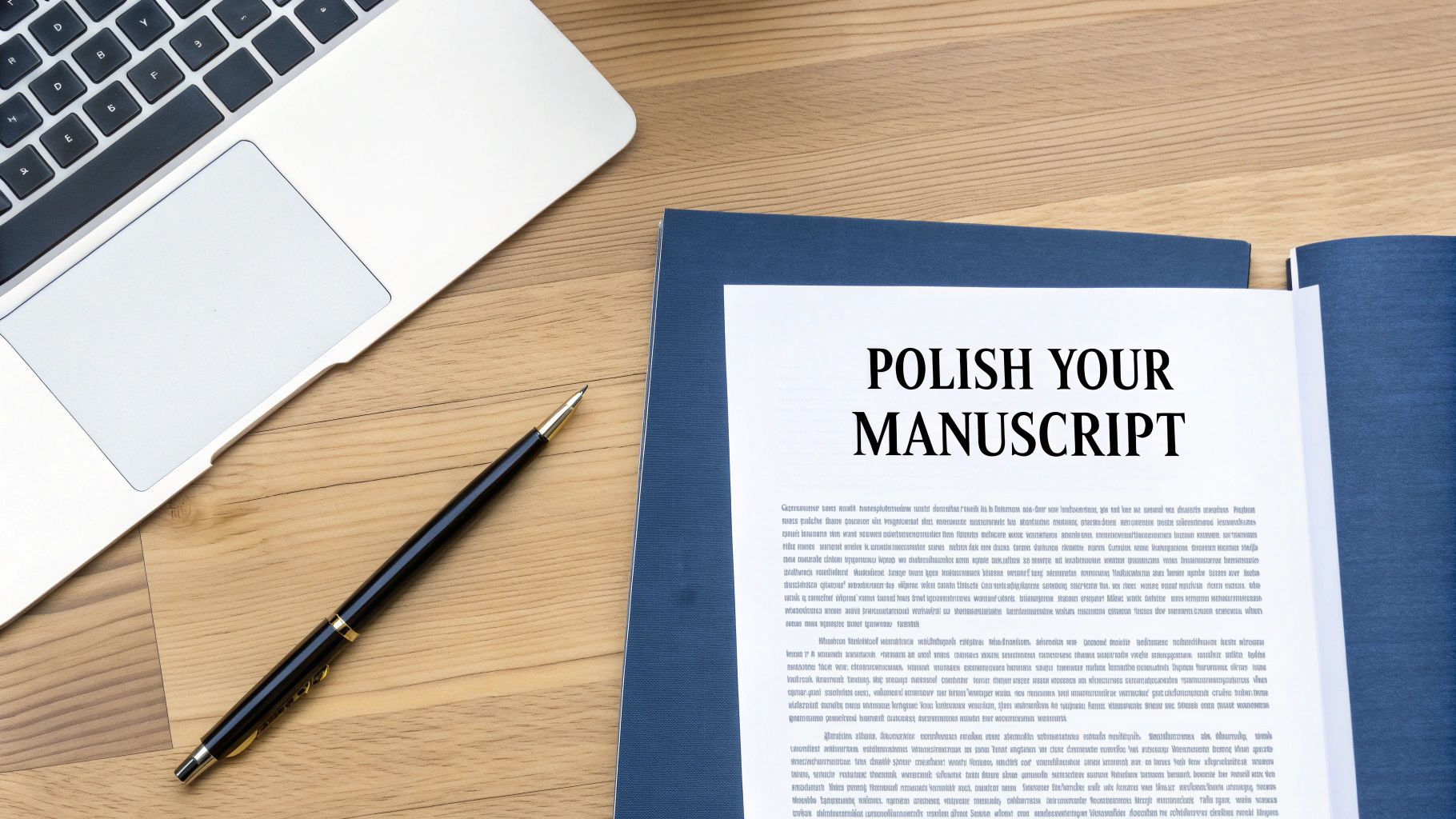
Before your book ever lands on an agent’s desk or in a reader's hands, it needs to be as clean and professional as you can possibly make it. This isn't just about running spell-check; it's a crucial part of the journey. A truly polished manuscript tells everyone—agents, publishers, readers—that you’re a serious author who respects the craft.
Let’s be blunt: a draft full of plot holes, awkward sentences, or glaring typos won't get a second look. It's an instant rejection. That's why investing in professional editing isn't an optional expense—it's a foundational step for anyone serious about getting published. It’s what turns your raw story into a market-ready book.
The Essential Layers of Editing
You wouldn't paint a house before the walls are built, right? Editing works the same way. It's a process with distinct stages, each building on the last. Skipping a step is a recipe for disaster.
-
Developmental Editing: This is your "big picture" edit. A developmental editor is looking at the very bones of your story—the plot, character development, pacing, and overall structure. They'll ask the hard questions. Is the middle sagging? Is your hero’s motivation a bit thin? Think of them as an architect for your narrative.
-
Line Editing: With the structure solid, it’s time to zoom in. A line editor goes through your manuscript sentence by sentence, focusing on the writing itself. Their job is to enhance your authorial voice, improve the flow, and make sure your prose is as sharp and engaging as possible.
-
Copyediting: Now we’re getting down to the nitty-gritty. The copyeditor is your grammar and punctuation expert. They hunt down spelling mistakes, syntax errors, and inconsistencies. Did your main character's eye color change in Chapter 12? The copyeditor will catch it.
After all this comes proofreading, which is the absolute final pass before the book goes public. To get a clearer sense of how these roles differ, check out our guide on proofreading vs. editing, which breaks it all down.
Finding the Right Editor for Your Book
Don't just hire the first editor you find. You need someone who gets your genre and connects with your vision. A brilliant sci-fi editor might not be the right person for your historical romance, and that's okay.
When you're looking for an editor, always ask for a sample edit. Most professionals will offer to edit a few pages (sometimes for a small fee, sometimes for free). This is your chance to see their editing style in action and make sure you’re a good fit. It's a small step that prevents a lot of headaches later.
A good editor doesn't just fix mistakes; they act as your book's first critical reader, showing you how to strengthen your story while preserving your unique voice.
The Power of Beta Readers
Before you even think about paying an editor, you can get incredibly valuable feedback from beta readers. These are simply people who agree to read your manuscript and give you their honest, reader-level reactions.
Beta readers are your first audience. They’ll tell you where they got bored, which character they fell in love with, and whether that twist ending actually worked. Find people who read your genre but aren't just going to tell you what you want to hear. Their feedback is pure gold for spotting problems you're too close to the project to see yourself.
Choosing Your Path: Traditional vs. Self-Publishing
You’ve done it. You have a polished manuscript, and now you’re standing at the biggest fork in the road of your author journey. The choice you make next—between traditional and self-publishing—will shape everything from your creative control and timeline to how much money you can make.
There's no single "right" answer here. The best path is the one that aligns with your specific goals, your budget, and frankly, your personality.
https://www.youtube.com/embed/yJiwM2AZZyo
Traditional publishing is what most people picture when they think of becoming an author. You find a literary agent, they sell your book to a publishing house, and you get the backing of a full team of experts. Editors, designers, marketers—it's all handled for you. The trade-off? You give up a lot of control, and the whole process can feel like it's moving at a snail's pace, often taking years.
Self-publishing, on the other hand, puts you in the driver's seat. You're the CEO of your book. You hire the editor, commission the cover design, and run your own marketing. It's a ton of work and you foot the bill for everything, but the creative freedom is absolute, and you can get your book into readers' hands much, much faster.
The Traditional Publishing Gauntlet
If you decide to go the traditional route, get ready to navigate a world of gatekeepers. Your first mission is to land a literary agent. This isn’t a casual search; it requires serious research to find agents who actually represent your genre. Then, you have to write a query letter so compelling it stands out in an inbox overflowing with thousands of other hopefuls.
The competition is absolutely brutal. We're talking about a massive global industry where acceptance rates for unsolicited manuscripts can be less than 1%. Publishers are businesses, and they're looking for a solid return on their investment. Your submission has to be perfect. If you're curious, you can find more data on the publishing industry's competitive nature.
Let's say you beat the odds and an agent offers you representation. They become your champion, pitching your manuscript to editors at various publishing houses. If an editor loves it, they'll offer a book deal, which usually includes a financial advance—an upfront payment against your future royalties.
The median advance for an author is somewhere around $25,000. Of course, this number can swing wildly depending on the book's potential and the author's platform. The good news is that advance is yours to keep, even if your book never earns it back in sales.
Taking the Reins with Self-Publishing
If the traditional waiting game sounds like your personal nightmare, self-publishing gives you a direct line to your audience. It's an entrepreneurial path where you call all the shots, starting with where you'll publish.
- Amazon Kindle Direct Publishing (KDP): This is the undisputed giant. With KDP, you can publish ebooks and print-on-demand paperbacks, tapping directly into Amazon's colossal customer base.
- IngramSpark: For authors wanting a wider reach, IngramSpark is a fantastic option. They distribute to a vast network that includes bookstores and libraries, many of which won't order from Amazon.
- Other Platforms: Don't forget services like Apple Books, Barnes & Noble Press, and Kobo Writing Life. Each one can help you connect with different pockets of readers around the world.
As an independent author, you're in charge of getting your own ISBNs (International Standard Book Numbers) and managing the whole production timeline. This means finding and hiring talented freelancers for editing, cover design, and book formatting.
Yes, there's a significant upfront investment, but the payoff can be huge. The potential for higher royalty rates—often between 40-70% compared to the much lower rates in traditional deals—is a major reason why so many writers choose this route. For a much deeper breakdown of the costs and benefits, check out our guide on whether self-publishing is worth it.
Ultimately, this decision comes down to what you value more: the creative control and speed of indie publishing or the validation and support of the traditional industry.
Designing a Book People Want to Pick Up
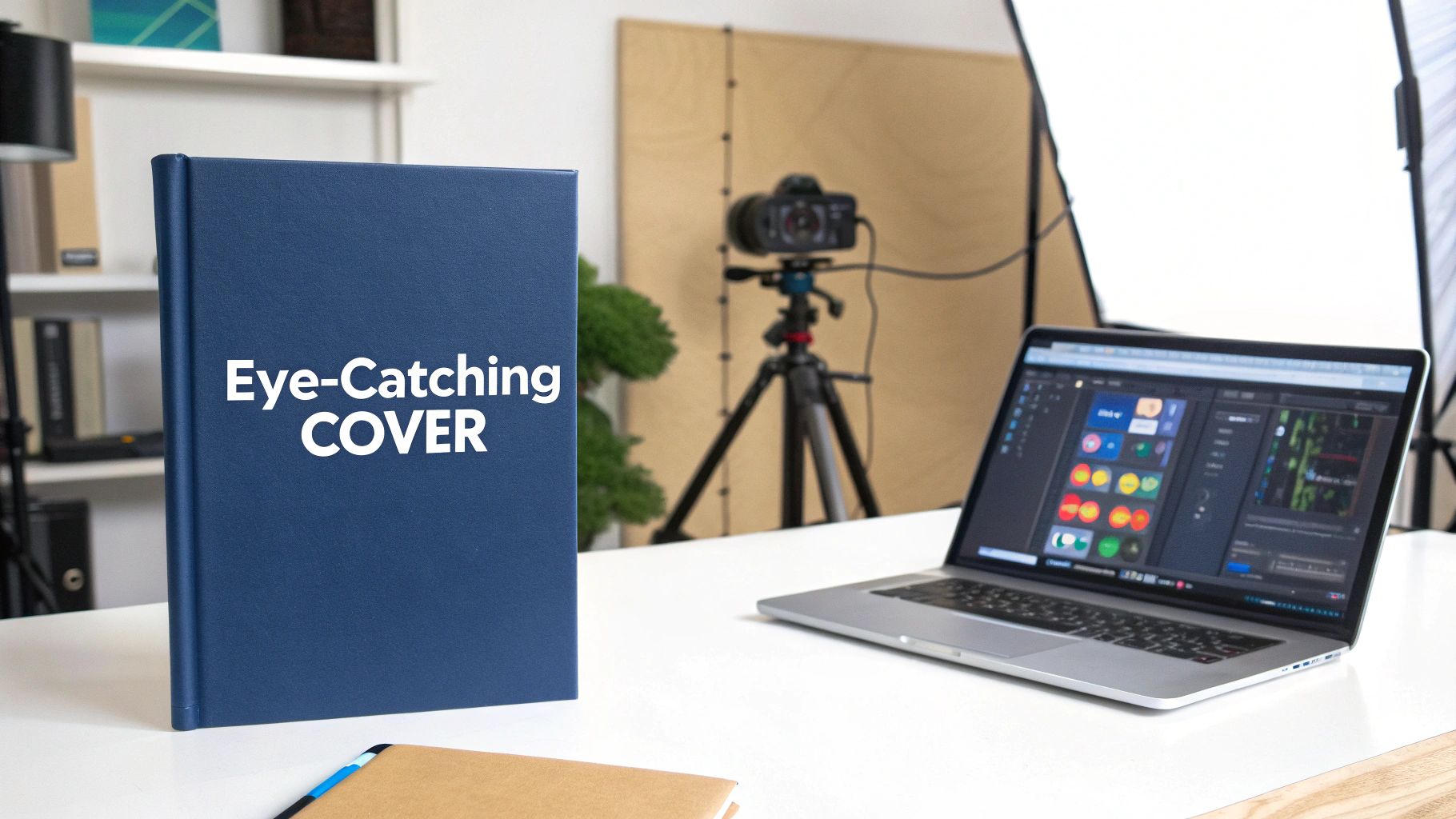
It’s the oldest cliché in the book because it’s true: people absolutely judge a book by its cover.
In that split second a potential reader spends scrolling through Amazon or walking past a bookstore shelf, your cover does all the talking. It's your single most important marketing tool. A professional, genre-appropriate cover immediately tells a reader that the story inside is worth their time and money.
An amateur cover, on the other hand, screams amateur author. It doesn’t matter if you’ve written the next great American novel; a shoddy cover will kill its chances before anyone even reads the first page. This is why investing in professional design is one of the smartest decisions an author can make.
Crafting a Compelling Cover
Your book cover has one main job: to grab your target reader and instantly signal your book’s genre and tone. A dark, moody cover with stark, bold text? Probably a thriller. A light, illustrated cover with a whimsical font? You're likely looking at a romance or contemporary fiction.
The surest way to get this right is to hire a professional designer who lives and breathes your genre. They already know the visual shorthand that speaks to your ideal audience.
- Find Genre Specialists: Start your search on platforms like Reedsy or 99designs. Don't just look at their work; look for a portfolio filled with books that look like yours.
- Provide a Clear Brief: Don’t just send them your manuscript. Give your designer a clear roadmap: genre, target audience, a few comparable book titles, and a summary of your story’s mood and key themes.
- Study the Market: Go to the bestseller lists for your category on Amazon. What trends do you see in the cover designs? Your cover needs to feel fresh and relevant, but it also has to fit in with reader expectations.
Your cover isn’t just art; it’s commercial packaging. Its primary goal is to make a potential reader stop, look closer, and click “buy” or pull the book off the shelf.
Why Interior Layout Matters
While the cover makes the first impression, the interior design dictates the entire reading experience. Professional typesetting and layout are about so much more than just picking a font. It's about creating a smooth, invisible journey for the reader.
Proper formatting ensures consistent spacing, readable text, and a clean layout that doesn’t pull focus from the story itself. A well-formatted book feels professional and shows respect for the reader. A poorly formatted one is jarring and can be frustrating enough to make someone put your book down for good.
Print on Demand vs. Offset Printing
So, how will your physical book actually get made? You have two main paths, and they serve very different needs.
- Print-on-Demand (POD): This is the engine behind platforms like Amazon KDP and IngramSpark. A book is only printed when a customer places an order. For you, this means no upfront inventory cost and no garage full of boxes. It's the standard choice for most independent authors because of its flexibility and low financial risk.
- Offset Printing: This is the traditional way, where large quantities (usually 1,000+ copies) are printed all at once. The per-unit cost drops significantly, but you’re on the hook for a huge upfront investment. You also have to figure out where to store all those books and how to ship them yourself.
For a new author, POD is almost always the more practical and financially sound choice. It lets you make your book available worldwide without the massive risk that comes with a large, traditional print run.
Finding Your Readers in a Crowded Market
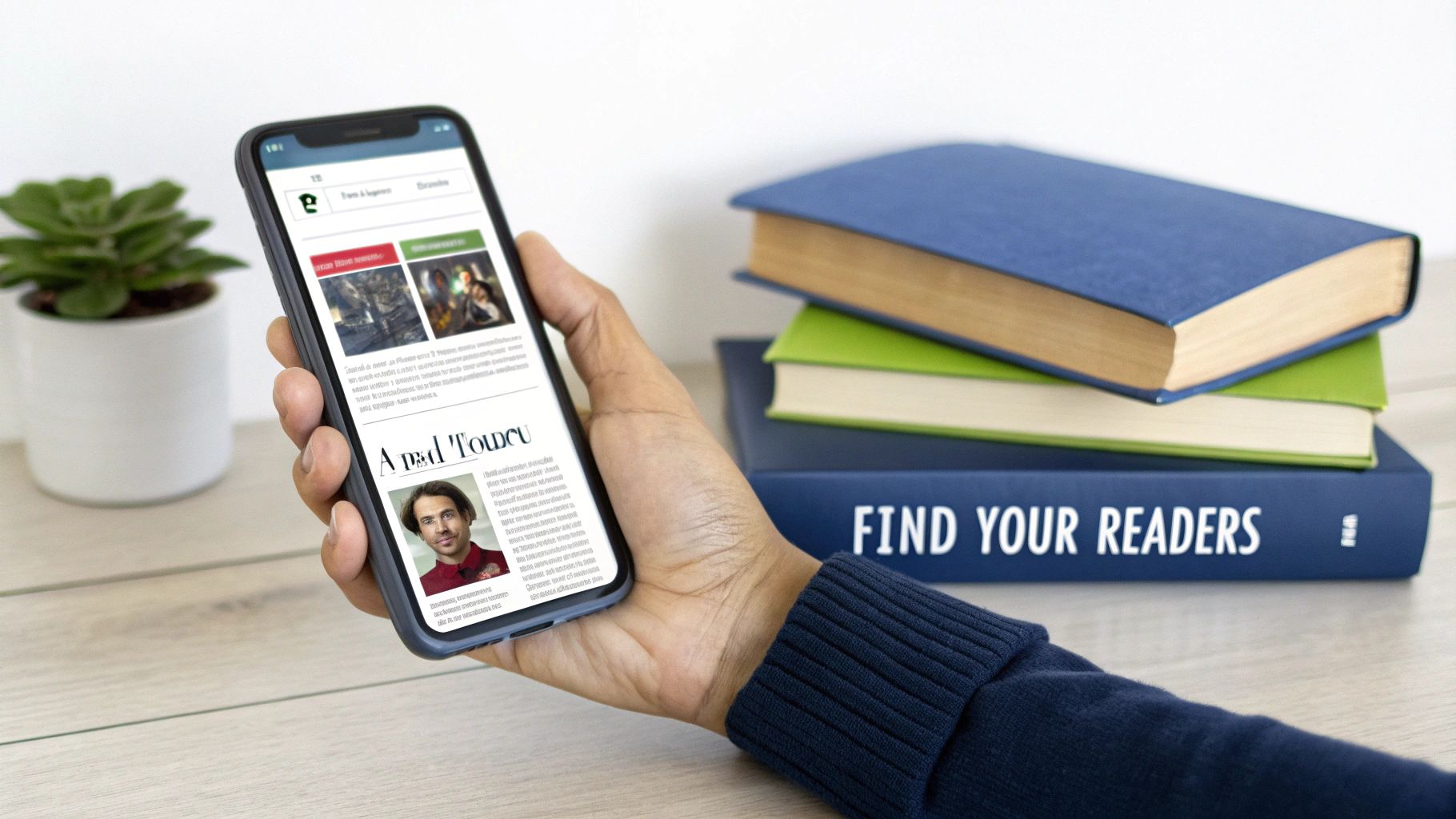
You did it. You finished the book. That was a marathon, but now it’s time for the sprint: finding the people who will actually read it. This is where you trade your author hat for an entrepreneur's, building a bridge between the world you created and the audience waiting for it.
The great news? You don't need a Madison Avenue budget to make a real impact. What you do need is a smart plan and a genuine desire to connect with readers. Modern book marketing isn't about shouting from the rooftops; it's about building a community, one reader at a time.
Building Your Author Platform
Think of your "author platform" as your digital footprint—it's how you reach readers. This is the sum of your website, your email list, and your social media presence. My advice? Don't try to be everywhere at once. Pick one or two spots where your ideal readers hang out and go deep there.
-
Your Author Website: This is your home base on the internet. Keep it clean and professional. It's the central hub where people can find your books, learn a bit about you, and—most importantly—sign up for your email list.
-
The Email Newsletter: I can't stress this enough: your email list is your single most valuable marketing asset. You don't own your social media followers, but you own your list. It's a direct line to your biggest fans, perfect for sharing news, exclusive content, or announcing your next book.
-
Strategic Social Media: Choose a platform that fits your genre and, just as crucial, your personality. If you write epic fantasy, you should probably be exploring the #BookTok community on TikTok. If your book is about business strategy, LinkedIn is likely a better bet. The goal is genuine connection, not just broadcasting ads.
Your Pre-Launch Marketing Playbook
A book launch that makes a splash starts months before publication day. This run-up period is your chance to build buzz and gather those precious early reviews. Those reviews are gold, especially for getting visibility on sites like Amazon.
Your first move should be to assemble an Advance Reader Copy (ARC) team. These are your early champions—readers who get a free digital copy of your book before anyone else, in exchange for posting an honest review on launch day. Services like Booksprout or StoryOrigin can be incredibly helpful for finding and managing these readers.
Your marketing shouldn't feel like a hard sell. It should feel like an invitation. You're inviting readers into your story's world, and the best way to do that is by sharing the story behind the story.
To really make your book resonate, tap into the power of storytelling in marketing. This isn't about gimmicks; it's about selling the experience and emotion of your book, not just the physical object.
Navigating the Distribution Maze
Getting your book into the hands of readers means understanding how it gets to stores in the first place. If you're self-publishing, you'll be using platforms that act as the middleman, connecting your book files to a global network of online retailers and libraries.
The global book publishing market is massive and still growing, projected to swell from $136.5 billion in 2024 to an estimated $229.5 billion by 2035. This boom is driven by digital platforms that have leveled the playing field for authors everywhere. Your job is to pick the right distribution channels to reach a slice of that expanding readership.
Answering Your Top Publishing Questions
Diving into the world of publishing for the first time can feel like learning a new language. You're suddenly hit with terms like "advances," "royalties," and "copyright registration," and it's easy to get overwhelmed. Let's clear up some of the most common questions I hear from authors.
I want to cut through the confusion and give you straight answers so you can make informed decisions.
How Much Do Authors Actually Earn?
Alright, let's talk about the money. It's the one thing everyone wants to know but can feel taboo to ask. The financial side of publishing isn't always straightforward.
With a traditional publisher, you'll usually get an advance against future royalties. Think of this as a signing bonus—it’s money the publisher is betting on your book's success. You get to keep it no matter what.
The big, splashy deals you read about are the exception, not the rule. For most authors, the median advance hovers around $25,000. Of course, this number can swing wildly depending on your genre, your author platform, and how well the publisher thinks your book will sell.
After your book has sold enough copies to pay back that advance (a term we call "earning out"), you'll start receiving royalty checks.
If you go the self-publishing route, the finances look completely different. You cover all the upfront costs for editing, design, and marketing. The trade-off? You get a much bigger piece of the pie, often between 40-70% in royalties for every sale. The earning potential can be huge if you find your audience.
Do I Need to Copyright My Book Before I Submit It?
This is a big source of anxiety for new writers, but you can relax. The simple answer is no.
Legally, in the United States, your work is copyrighted the moment it's written—or, as the law puts it, "fixed in a tangible medium." When you sign a deal with a traditional publisher, their legal team will handle the official registration with the U.S. Copyright Office for you. It's part of the package.
If you're self-publishing, this is a task you'll take on yourself. While you don't have to register your copyright to publish, it's a smart move. It creates a public record of your ownership and is a legal prerequisite if you ever have to sue someone for infringement.
How Important Are Digital and Audio Formats?
They’re not just important; they're essential. While we all love the feel of a physical book, the real growth in today's market is happening on screens and in headphones.
Recent data shows the traditional print book market took a small 1.6% dip in early 2025, while eBooks and audiobooks continue to climb. That's a clear signal that a modern publishing strategy has to include digital formats to reach the widest possible audience. You can dig into more of these publishing market trends to see the numbers for yourself.
Offering your book in multiple formats isn't just an add-on anymore. It’s a fundamental part of a successful book launch.
Ready to turn your manuscript into a professionally published book? The expert team at BarkerBooks has helped over 7,500 authors bring their stories to life with comprehensive services from editing and design to global distribution. Start your publishing journey with us today!
